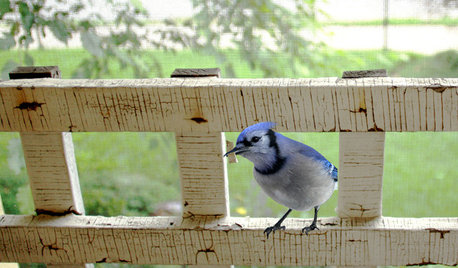Plants I'm curious about
springcherry
19 years ago
Related Stories

GARDENING FOR BIRDSBackyard Birds: Meet Some Clever and Curious Jays
Boisterous jays provide plenty of backyard bird-watching in winter. Here’s how to identify all the varieties and welcome them into your yard
Full Story
LANDSCAPE DESIGNGreat Design Plant: Lively Fountain Grass Thrives Just About Anywhere
Enjoy fountain grass for its exuberant form, long-lasting color and texture for borders and more
Full Story
FUN HOUZZEverything I Need to Know About Decorating I Learned from Downton Abbey
Mind your manors with these 10 decorating tips from the PBS series, returning on January 5
Full Story
GARDENING GUIDESNew Ways to Think About All That Mulch in the Garden
Before you go making a mountain out of a mulch hill, learn the facts about what your plants and soil really want
Full Story
HOUZZ TOURSMy Houzz: Vancouver Artist's Curious, Collected Home
Family memorabilia and intriguing collections tell a lively story in a Canadian artist's one-bedroom home
Full Story
PRODUCT PICKSGuest Picks: 20 Curious Finds
Why relegate curiosities to a cabinet? Add interest around the home with unique furniture and accents
Full Story
WINTER GARDENING6 Reasons I’m Not Looking Forward to Spring
Not kicking up your heels anticipating rushes of spring color and garden catalogs? You’re not alone
Full Story
WORKING WITH PROS10 Things Decorators Want You to Know About What They Do
They do more than pick pretty colors. Here's what decorators can do for you — and how you can help them
Full Story
COLORHave You Heard the Hues? 15 Colors You May Not Know About
Name-drop these shades at holiday parties — or better, try one on your walls — and expand your palette possibilities
Full Story
BEDROOMSGuessing Game: What Might Our Bedrooms Say About Us?
For entertainment only; actual accuracy may vary. Always don fun goggles and engage your imagination before playing!
Full Story





blueheron
neverenough
Related Professionals
Surprise Landscape Contractors · Clark Landscape Contractors · Concord Landscape Contractors · Danvers Landscape Contractors · Post Falls Landscape Contractors · Ridgewood Landscape Contractors · Sun City Center Landscape Contractors · Raytown Landscape Contractors · King of Prussia Carpenters · Bethany Decks, Patios & Outdoor Enclosures · Bonita Decks, Patios & Outdoor Enclosures · Kernersville Decks, Patios & Outdoor Enclosures · Universal City Decks, Patios & Outdoor Enclosures · Conyers Siding & Exteriors · Panama City Siding & Exteriorskatob Z6ish, NE Pa
springcherryOriginal Author
ArborBluffGirl
springcherryOriginal Author
carol23_gw